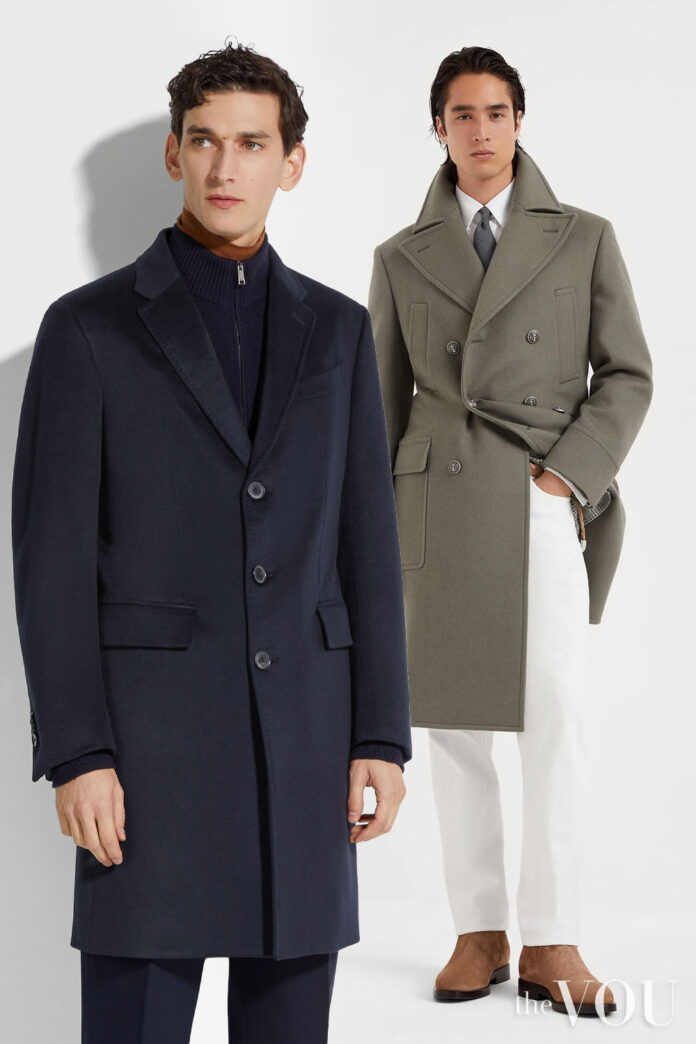Knowing which coats are best to create a stylish look is paramount for men who want to depict success, wealth, and refined sophistication.
Tailored coats are more than shields against bad weather. They are some of the most powerful garments conveying success and social status.
In this article, we’ll introduce you to the main coat styles you need to know and how to style them to make an impeccable impression in any setting, from the boardroom to formal events.
Let’s take the first step in cultivating a timeless capsule wardrobe that speaks volumes about your taste and status without ever saying a word.
Coat Types Matter – Here’s Why
Match the Occasion
Wearing the right coat for the right event is key, as you wouldn’t pair a casual Bomber jacket at a business meeting so, always consider the setting.
Formal events call for formal coats like a Chesterfield or Alpaca Coat. For casual hangouts, you’ve got more freedom as garments like quilted jackets or leather jackets are fair game.
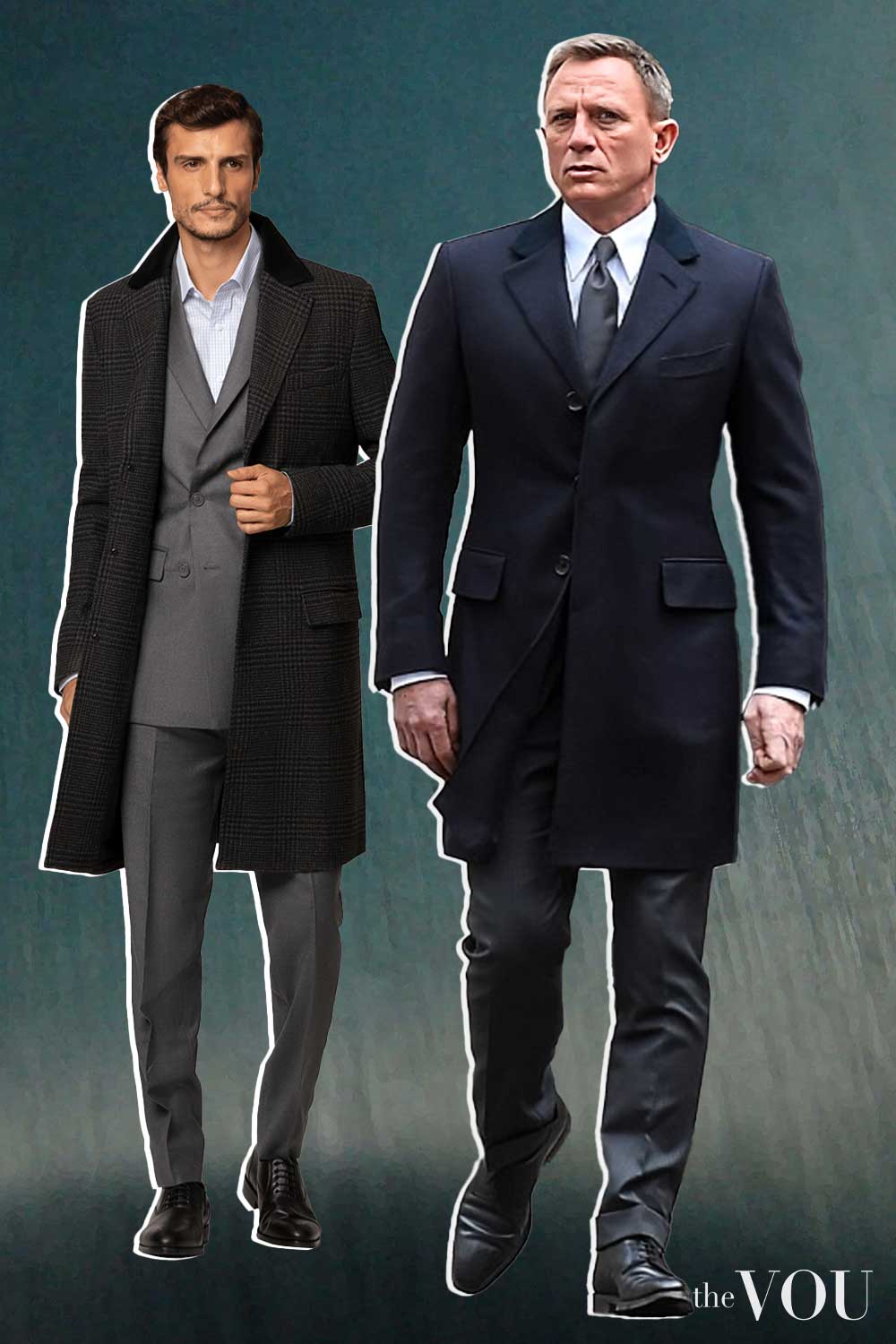
Perfect Style
Your coat is a quick snapshot of who you are. Want to look put-together and professional? Wear an overcoat.
Going for a more laid-back vibe? A denim jacket has your name all over it. Each coat carries a message, so pick one that aligns with your style.

Weather Appropriate
Picking a coat isn’t just about style but also practicality. The weather isn’t just small talk; it’s crucial in your choice.
Light garments like trench coats are excellent for milder weather, but when winter sets in, you’ll need something with a bit more heft.
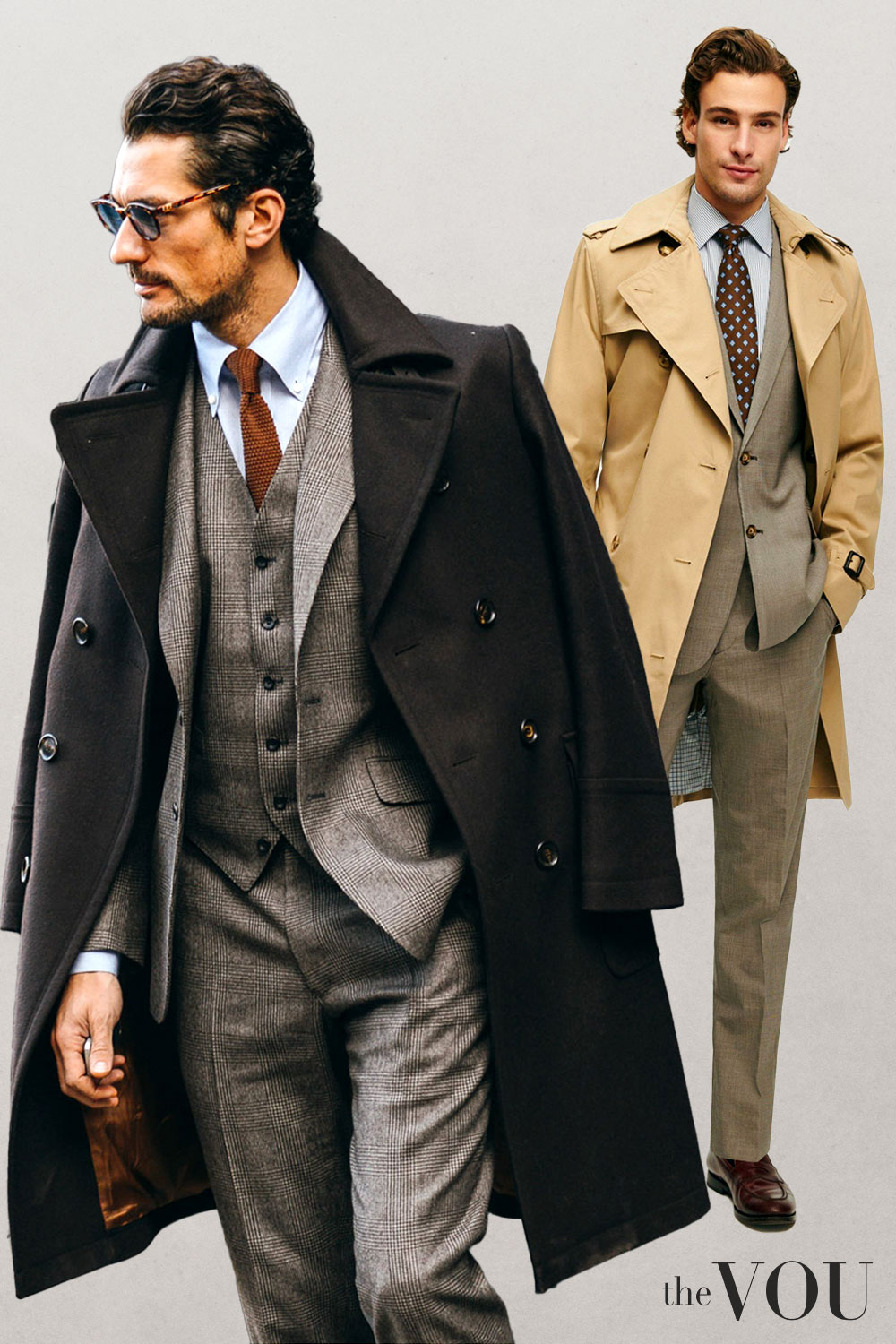
All Coat Types You Should Know
Now that we’ve established why the coat type is critical let’s dive into garment specifics and how to style them best.
Below is a comprehensive table detailing the types of coats every man should know and wear.
The table details whether each coat type works with a suit, what outfit complements it best, the ideal seasons, where it’s most appropriately worn, and its defining features.
| Coat Type | Suit? | Outfit Idea | Season | Occasion | Features |
|---|---|---|---|---|---|
| Chesterfield | Yes | Suit, formal shirt, dress shoes | Winter, Fall | Formal, Business | Simple and elegant |
| Overcoat | Yes | Suit, dress shoes, formal shirt, tie | Winter, Fall | Formal, Business | Classic and formal |
| Topcoat | Yes | Suit, formal shirt, tie, dress shoes | Fall, Winter | Formal, Business | Light |
| Mac Coat | Yes | Suit or business casual trousers, shirt, dress shoes | Fall, Winter | Formal, Business | Functional |
| Trench Coat | Yes | Suit, or chinos, dress shirt, and leather shoes | Spring, Fall | Formal, Business | Double-breasted and belted |
| Raincoat | Yes | Business attire or casual wear | Not Summer | Casual, Business | Water-resistant |
| Double-Breasted Overcoat | Yes | Suit, formal shirt, dress shoes | Winter, Fall | Formal, Business | Classic and formal |
| Alpaca Coat | Yes | Suit, formal shirt, dress shoes | Winter | Formal, Business | Luxurious material |
| Padded Piece Blazer | Yes | Business casual, chinos, shirt, loafers | Fall, Winter | Business, Semi-Formal | Padded insulation |
| Corduroy Jacket | No | Chinos or jeans, casual shirt or turtleneck, loafers or boots | Fall, Spring | Casual, Semi-Formal | Textured |
| Funnel Neck Coat | Yes | Crisp shirt, tailored trousers, brogues or loafers | Fall, Winter | Business, Semi-Formal | Chic, Functional |
| Quilted Jacket | No | Jeans or chinos, casual shirt, casual shoes | Fall, Winter | Casual | Quilted pattern |
| Pea Coat | No | Jeans or chinos, sweater, casual shoes/boots | Winter, Fall | Casual, Semi-Formal | Double-breasted |
| Field Jacket | No | Chinos/jeans, casual shirt, casual shoes | Spring, Fall | Casual, Outdoor | Military-inspired |
| Duffle Coat | No | Casual pants, knit sweater, boots | Winter | Casual | Toggle fastenings |
Chesterfield Coat
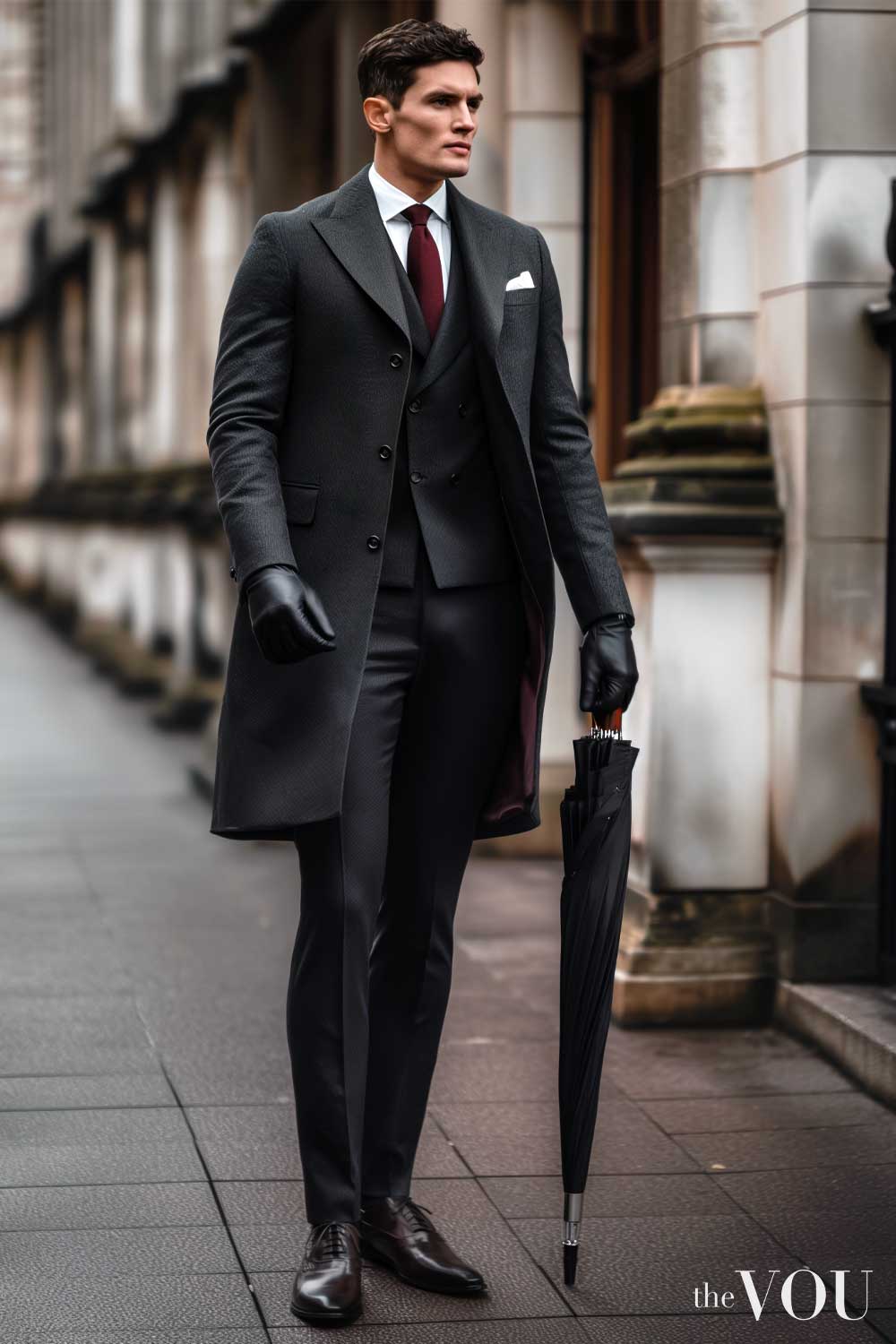
In a superb blend of elegance and functionality, the Chesterfield coat is a traditional choice for the discerning gentleman.
Garment Type: A single-breasted overcoat with a velvet collar. A classic coat that screams sophistication.
How to Style: Pair it with a suit, a formal dressy shirt for work, and men’s dress shoes. Stick to monochrome shades like black, navy, or grey for a timeless look.
When to Wear: Best for Winter and Fall. Ideal for Formal and Business settings.
Why Own One: Versatility – this jacket is the Jack of all trades in formal outerwear—elegant but not overly showy.
Overcoat

The overcoat is the go-to option for men wanting to make a strong style statement without compromising comfort.
Learn what an overcoat is and how to wear one and rule your Monday-to-Friday routine during winter.
Garment Type: A long coat with a tailored fit exudes professionalism and classic style.
How to Style: A suit, formal shirt, dress shoes, and tie will do. Go neutral—think black, charcoal, or camel.
When to Wear: Perfect for Winter and Fall. Suited for Formal and Business gatherings.
Why Own One: Every stylish man should own an Overcoat, the cornerstone of any formal winter wardrobe.
Topcoat

The Topcoat offers the perfect middle ground when you want the elegance of an Overcoat without the bulk.
Garment Type: Similar to an Overcoat but lighter, making it more versatile across seasons.
How to Style: Your best bet is suits, formal shirts, ties, and dress shoes. Keep it simple with greys, blacks, or navy.
When to Wear: It’s a good pick for Fall and Winter. It’s perfect for Formal and Business events but flexible enough for less formal ones.
Why Own One: Multi-season use – this is the Overcoat’s less bulky cousin, ideal for a wider range of temperatures.
Mac Coat

The Mac Coat is a stellar choice for the modern man seeking a blend of traditional tailoring and contemporary style.
Garment Type: A lightweight waterproof coat known for functional elegance.
How to Style: It goes well with a suit or business casual trousers, shirt, and dress shoes.
When to Wear: Ideal for Fall and Winter. Suited for Formal and Business settings.
Why Own One: Functional elegance – combines a raincoat’s durability with a formal coat’s elegance.
Trench Coat
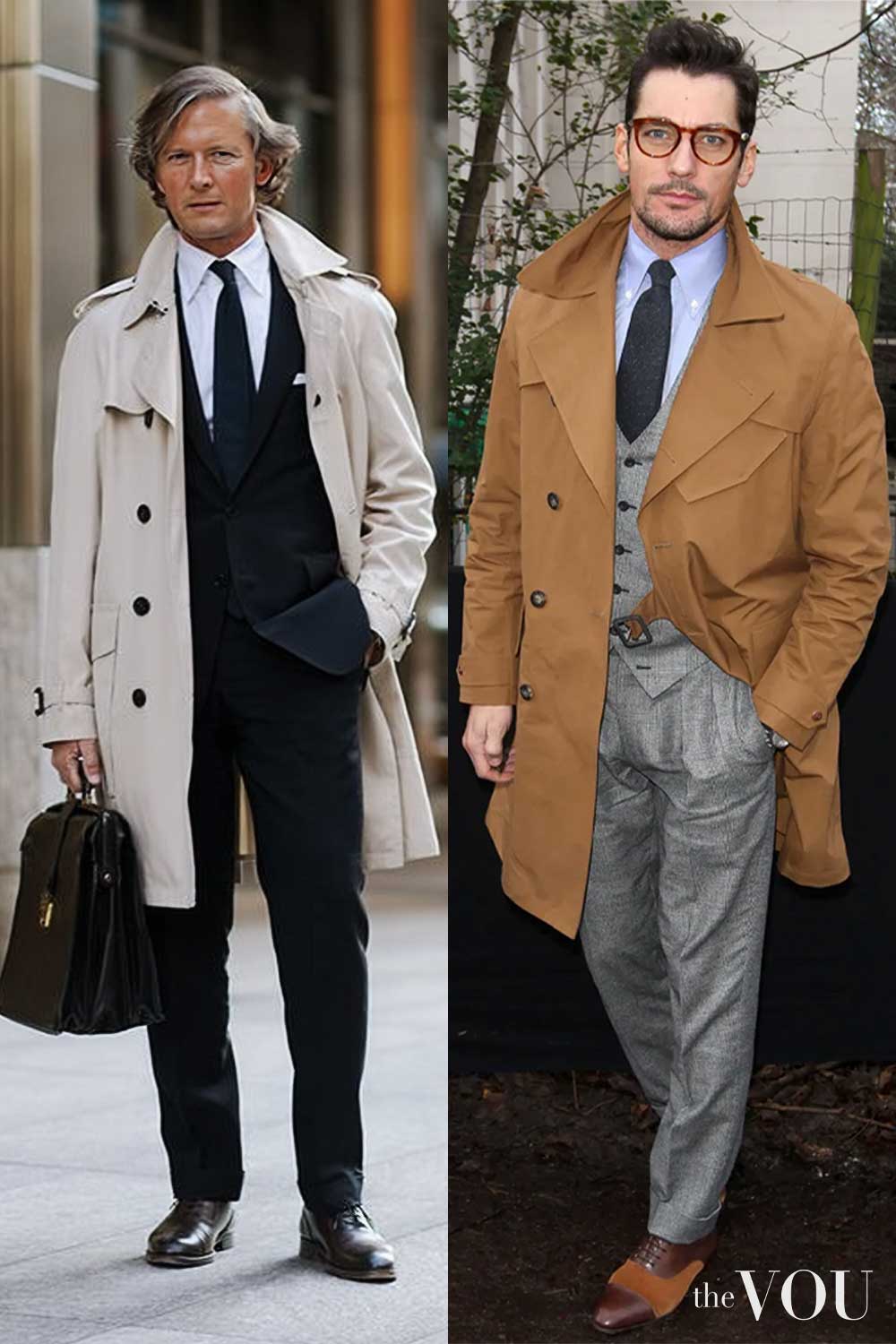
A true icon in men’s fashion, the Trench Coat adds a touch of mystery and sophistication to any outfit.
Garment Type: A double-breasted, belted coat from water-resistant material.
How to Style: Wear it over a suit or pair it with chinos, a dress shirt, and leather shoes.
When to Wear: Best for Spring and Fall. Versatile enough for Formal and Business settings.
Why Own One: Timeless style – an Old Money wardrobe staple that has stood the test of time.
Raincoat
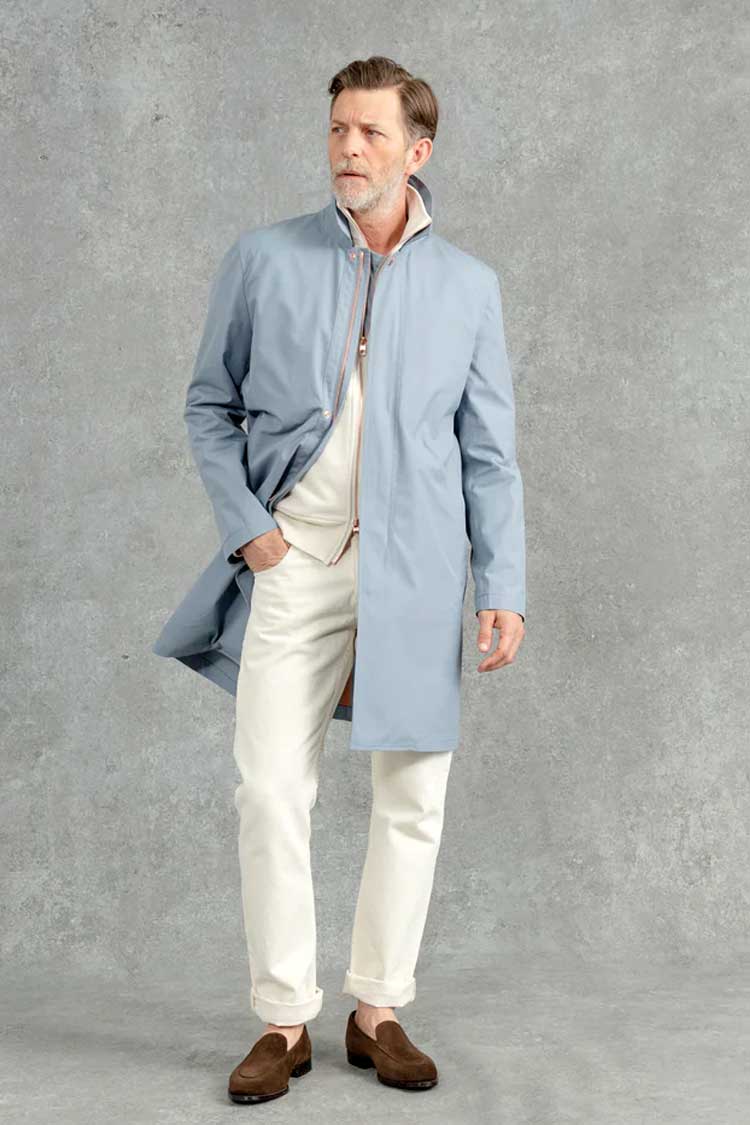
Don’t let bad weather cramp your style; the Raincoat keeps you dry without sacrificing looks.
Garment Type: A water-resistant coat that ranges in style from casual to business-ready.
How to Style: Compatible with business attire or casual wear, depending on the material and style.
When to Wear: Any season except Summer. Good for both Casual and Business occasions.
Why Own One: Practicality – a stylish way to stay dry.
Double-Breasted Overcoat

The Double-Breasted Overcoat speaks volumes when you want to make a statement with your outerwear.
Garment Type: An overcoat with a double row of buttons, offering a more formal look.
How to Style: Ideal with a suit, formal shirt, and dress shoes.
When to Wear: Perfect for Winter and Fall. Suited for Formal and Business events.
Why Own One: The epitome of formality and adds an extra touch of class to any outfit.
Alpaca Coat

Luxury meets practicality in the Alpaca Coat, offering unparalleled comfort and style.
Garment Type: A coat made from luxurious Alpaca fibres, known for their softness and warmth.
How to Style: A suit, formal shirt, and dress shoes work best.
When to Wear: Best during the Winter season. Ideal for Formal and Business settings.
Why Own One: Comfort and luxury – the alpaca fibres provide unmatched softness and insulation.
Funnel Neck Coat
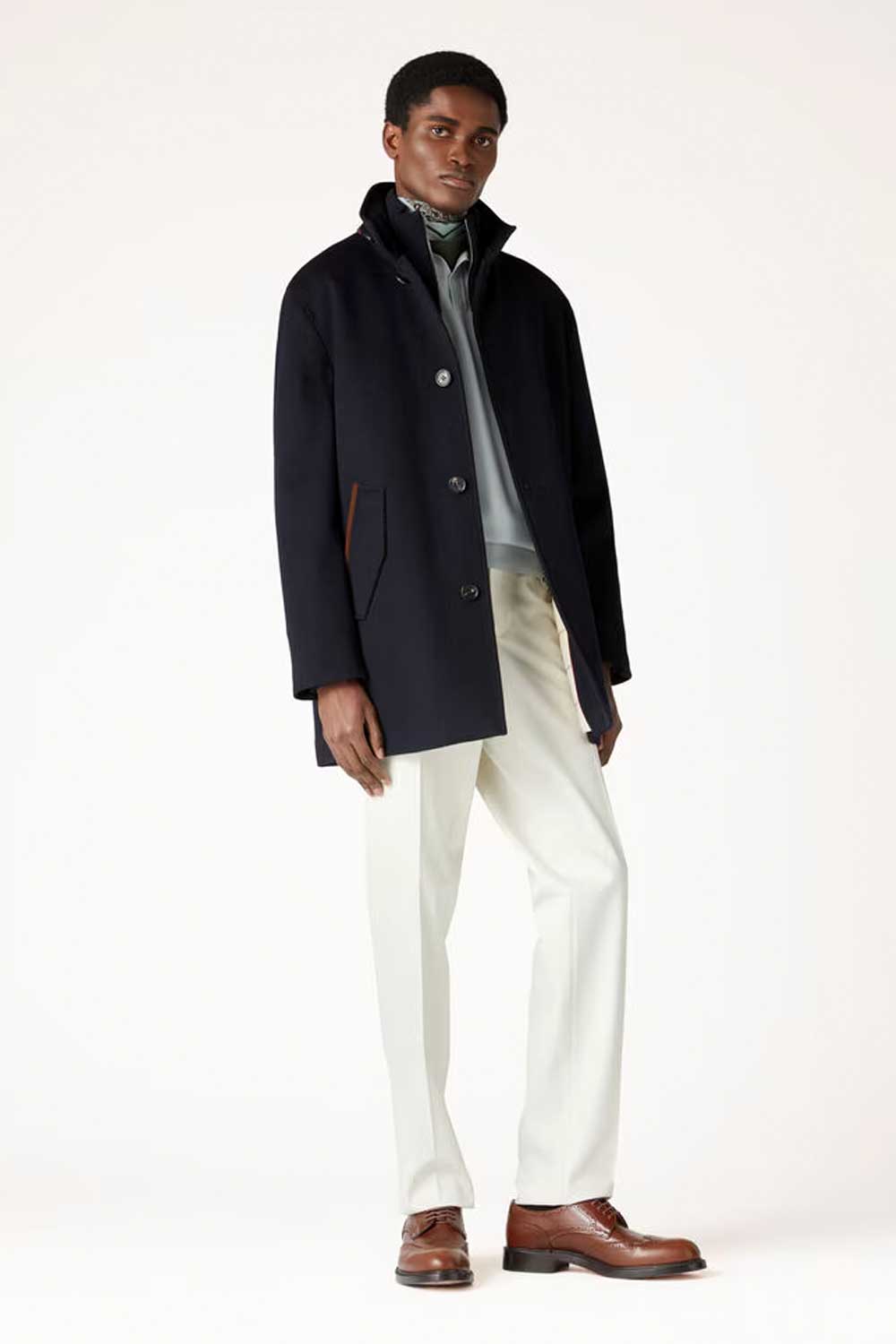
A modern twist on classic outerwear, the Funnel Neck Coat delivers warmth with elevated style.
Garment Type: A coat featuring a funnel-shaped neck that offers extra warmth and a contemporary aesthetic.
How to Style: It pairs seamlessly with business-casual outfits, such as a crisp shirt, tailored trousers, and brogues or loafers.
When to Wear: Best for Fall and Winter. Ideal for Business Casual and Semi-Formal settings.
Why Own One: Chic functionality – the funnel neck adds a modern edge to your look and provides extra warmth on those colder days. It’s the perfect blend of practicality and flair, making it a valuable addition to any modern man’s wardrobe.
Padded Piece Blazer or Overcoat

This is not your average blazer. The padded piece blazer is the ultimate fusion of style and comfort.
Garment Type: A blazer or overcoat and padded jacket hybrid, offering warmth and a semi-formal look.
How to Style: Style the blazer with business casual attire – e.g. chinos, a shirt, and loafers.
When to Wear: Ideal for Fall and Winter. Suited for Business and Semi-Formal occasions.
Why Own One: A versatile cold-weather option when a regular blazer just won’t cut it.
Quilted Jacket

Nothing beats the comfort and versatility of a Quilted jacket for laid-back weekends and casual outings.
Garment Type: A casual jacket with a quilted pattern for added texture and warmth.
How to Style: It goes well with jeans or chinos, a casual shirt, and casual shoes.
When to Wear: Perfect for Fall and Winter. Best for Casual outings.
Why Own One: It’s an easygoing style jacket that looks great without trying too hard.
Pea Coat

Embrace the sailor within you with the Pea Coat or Peacoat, a naval-inspired classic that stands the test of time.
Garment Type: A short, double-breasted coat made of heavy wool.
How to Style: Pair it with jeans or chinos, a sweater, and casual shoes or boots.
When to Wear: Best for Winter and Fall. Suited for Casual and Semi-Formal settings.
Why Own One: Rugged elegance – A masculine staple that balances form and function; learn more about this coat type in our peacoats guide.
Field Jacket
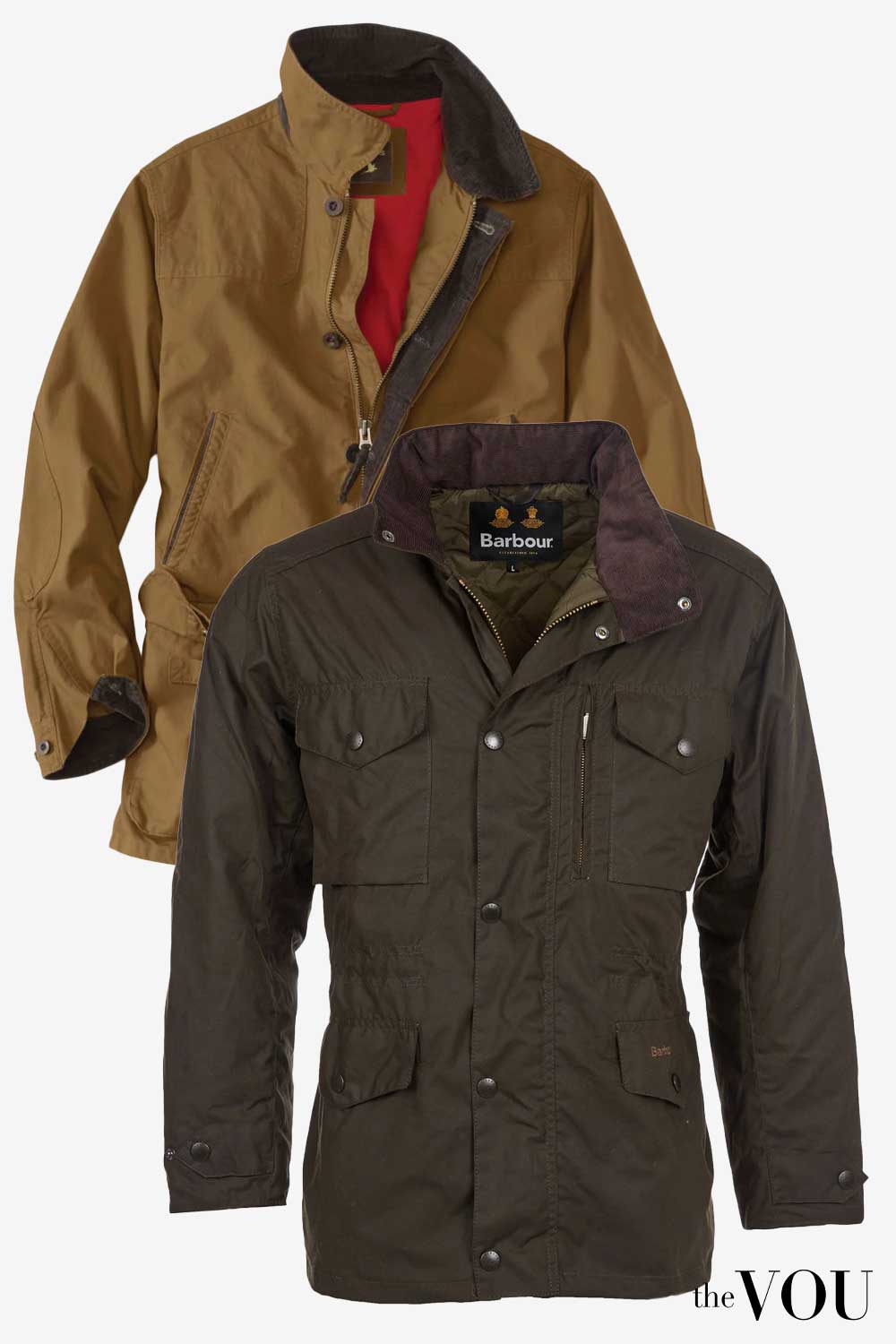
For the adventurous man, the Field Jacket offers both practicality and a touch of rugged style.
Garment Type: A military-inspired jacket featuring multiple pockets and a relaxed fit.
How to Style: Wear it with chinos or jeans, a casual shirt, and casual shoes.
When to Wear: Ideal for Spring and Fall. Perfect for Casual and Outdoor activities.
Why Own One: Utility – practical and stylish, with plenty of room for essentials.
Duffle Coat
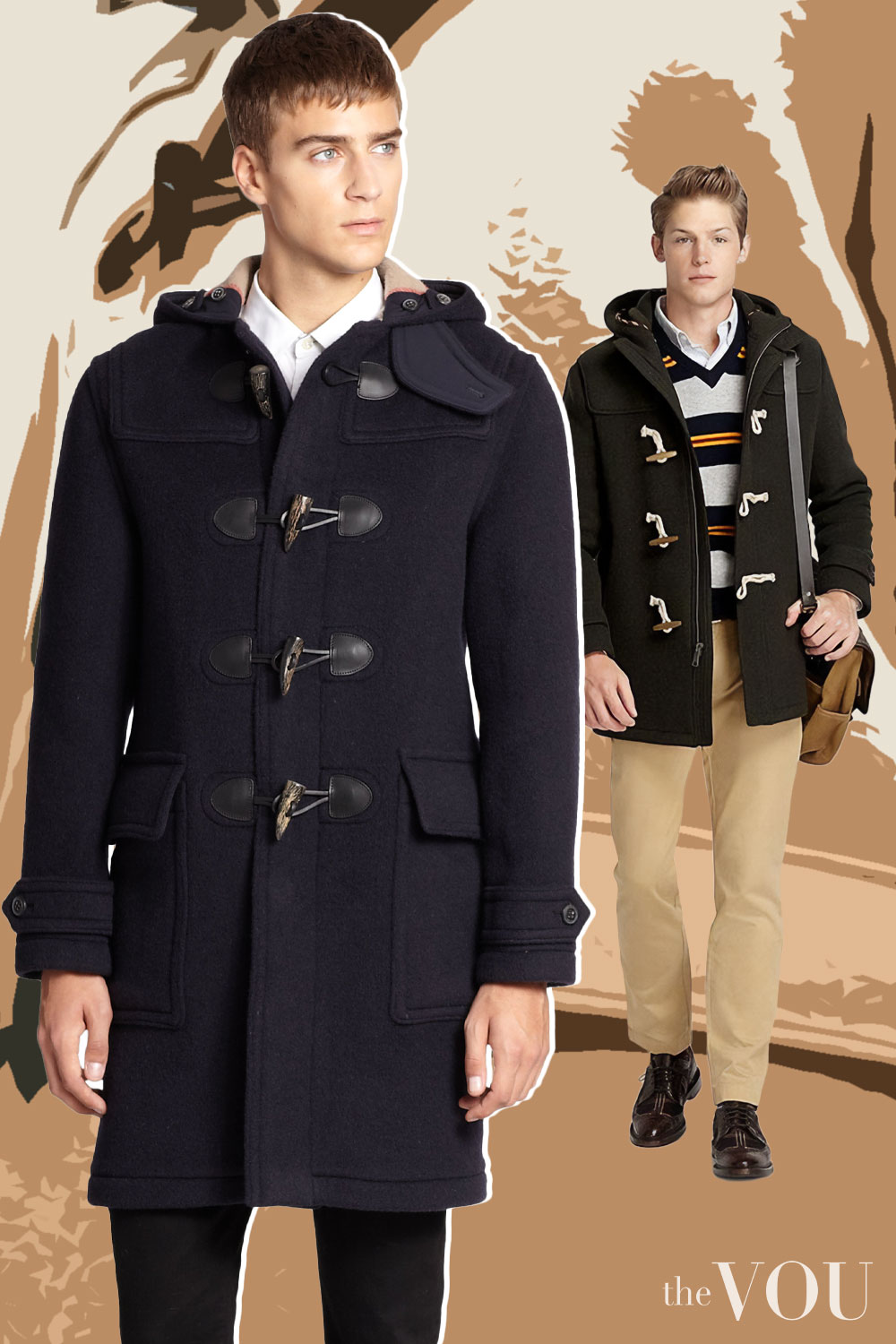
An enduring classic with British roots, the Duffle Coat is your ticket to a cosy yet cultured style.
Garment Type: A long, hooded coat with unique toggle fastenings.
How to Style: Ideal with casual pants, a knit sweater, and boots.
When to Wear: Best for Winter. Suited for casual settings.
Why Own One: Nostalgic charm – with iconic toggles, this classic garment has a youthful spirit.
Corduroy Jacket
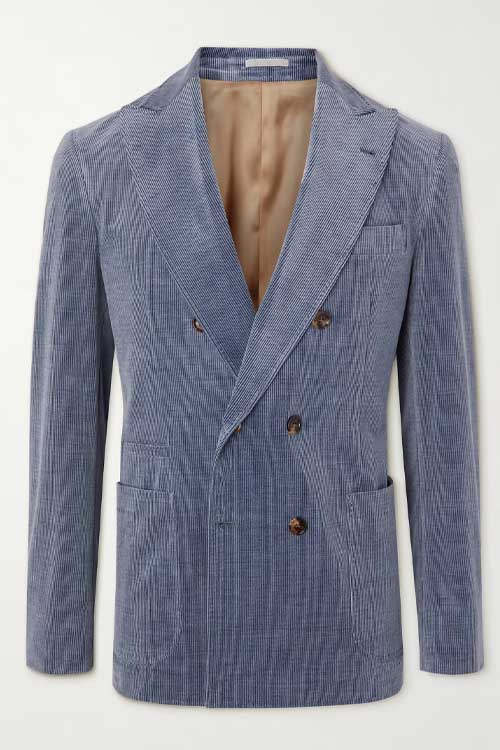
Step into a blend of vintage vibes and modern comfort with the Corduroy Jacket.
Garment Type: A casual jacket made of corduroy fabric, known for its distinctive wale pattern of raised ridges.
How to Style: It looks great with chinos or jeans, a casual shirt or turtleneck, and loafers or boots.
When to Wear: Ideally suited for Fall and Spring. Works well for Casual and Semi-Formal settings.
Why Own One: Corduroy adds a unique textural element to your outfit, allowing for more complex and intriguing looks. It’s versatile enough to be laid-back and dressy, making it a must-have in your wardrobe.
How to Choose Your Coat
Overcoat vs Pea Coat
The Overcoat and Pea coat are winter staples made from wool and provide good insulation, but they have different needs and styles.
Formality
Wear an Overcoat at formal settings and a Pea coat at casual to semi-formal occasions. The Overcoat is worn over suits and is more formal, while the Pea Coat has a more casual, nautical flair.
Length
Overcoats cover the knee longer, while Pea coats are shorter and hit at the hip or mid-thigh.
Lapels
Overcoats have notch lapels, while Pea Coats come with broad and double-breasted lapels.
Chesterfield Coat vs Overcoat
At first glance, both are long, formal coats made of wool or a wool blend, but… the devil is in the details.
Design
The Chesterfield has a velvet collar and a more streamlined look. Overcoats may have a back vent and a fuller cut.
Versatility
Chesterfields are versatile. You can style them with a double-breasted suit for a formal occasion or wear them as casualwear, whereas Overcoats are more formal.
If you’re looking for elegance with a touch of flair, go for a Chesterfield. The Overcoat is your best bet for a more traditional, formal look.
Trench Coat vs Overcoat
The Trench coat and Overcoat are stylish formal wear and can be paired with suits but serve different seasonal needs.
Material
Trench coats are made from water-resistant materials like gabardine, while Overcoats are made from wool.
Season
Trench Coats are ideal for Spring and Fall transitional seasons, while Overcoats are built for the colder months.
Opt for a Trench Coat in milder weather and transition to an Overcoat as temperatures drop.
Duffle Coat vs Pea Coat
If you’re looking for a casual winter coat, the Duffle Coat and Pea Coat are strong contenders.
Closures
Duffle coats come with unique toggle fastenings, while Pea Coats are double-breasted with buttons.
Hood
Duffle coats come with a hood, while Pea coats do not.
The Duffle Coat is ideal for a relaxed, youthful look. The Pea Coat, meanwhile, offers a more structured, naval-inspired style.
Single-Breasted Coat vs Double-Breasted Coat
Both types are in styles like Overcoats, Trench coats, and Pea coats, but the number of buttons and how they’re configured can alter a coat’s vibe and formality.
Button Layout
Single-breasted coats have one to three buttons in a single line, while double-breasted coats have a two-column button setup.
Formality
Double-breasted coats are considered more formal and imposing than single-breasted versions.
Versatility
Single-breasted coats are more versatile, pairing well with casual and formal outfits.
Go single-breasted for versatility and double-breasted for a bold, formal statement.
Topcoat vs Pea Coat
While both are made from wool or wool blends and as staples for colder weather, the Topcoat and Pea coat cater to different tastes and occasions.
Length
Topcoats extend to the mid-thigh or knee, while Pea coats are shorter and hit at the hip or mid-thigh.
Formality
Topcoats are more formal and pair well with business attire, while Pea coats are quite casual, depending on the context.
Design
Topcoats come in single-breasted styles, while Pea coats are double-breasted with broad lapels.
Choose a Topcoat for a more elongated, formal look and a Pea coat for a casual yet classic style.
FAQs
What is the Warmest Coat Material?
Wool is the warmest coat material for winter. The purer, the better. Of course, pure wool comes at a certain expense.
If you want something less expensive, go for a wool blend, but look for a material with a higher percentage of wool than the synthetic fabric in the mixture.
A wool and nylon blend is great if you want a coat that lasts a couple of years, as nylon adds great strength to the material mixture.
What Coat is Best for Winter?
Coats made from wool, such as Peacoats, Duffle coats, and Chesterfield, are the most suitable for the winter.
Trench coats should be avoided for the winter, as the cotton fabric does not shield you from icy weather.
What is the Difference Between a Jacket and a Coat?
Jackets are considered more casual, lightweight clothing items, while coats are considered a more formal option and are made of heavier fabric.
Moreover, coats are longer and reach knee length or below the knee, while jackets stay at the hip.
What is a Car Coat, and why is it called that?
A Car Coat is a mid-length coat designed originally for automobile drivers.
Its primary purpose was to shield drivers from the elements when cars were still without proper cabins.
Car coats are tailored to end at the thigh and are made from heavy materials to provide warmth, though their design has evolved to match contemporary fashion.
Are Parka Coats suitable for urban wear?
While Parka Coats were designed for cold weather and rugged conditions, their functionality and stylish appearance make them popular for urban wear.
Modern parkas come with fur-lined hoods and are waterproof, making them practical yet trendy for city life during cold seasons.
How does a Trench Coat differ from a Mac Coat?
The Trench and Mac coats (or Mackintosh) are raincoats by origin but have distinguishing features.
The Trench coat is longer, reaching below the knee. It is double-breasted, belted, and has epaulettes and storm flaps.
On the other hand, the Mac coat is simpler in design, single-breasted, and tends to be a bit shorter.
It’s also made of rubberised fabric, ensuring waterproof qualities.
Is the Overcoat a formal wear garment?
Traditionally worn over suits and business attire, overcoats were considered formal attire. However, modern fashion pairs overcoats with formal wear and casual apparel like jeans and sneakers, striking a balance between elegance and casual chic.
Why are pea coats double-breasted?
The Peacoat, with its naval origins, is double-breasted for functionality.
The design offers extra fabric layers, providing warmth and protection against harsh sea winds.
The overlapping fabric and its heavy woollen material made it ideal for sailors.
Over time, the design became iconic and is as much about style as warmth.
Conclusion
So there you have it, gents—the ultimate guide to levelling up your outerwear game for a classic, old-money look.
From Chesterfield’s suave sophistication to the Varsity jacket’s youthful vibes, there’s a coat for every man, mood, and weather condition.
Whether you’re braving the winter chill or looking to amp up your style, remember: the right coat isn’t just an investment in fabric; it’s an investment in you.
So choose wisely, step out confidently, and make every moment a fashion statement worth remembering.
Take the First Step With The VOU’s Styling Quizzes
Start your style journey with our free resources. First, take our Face Shape Quiz to confirm your face shape and receive initial styling guidance.
Then, discover your most flattering colours with our Seasonal Colour Analysis Quiz.
Learn which garment styles suit you best through our Body Shape Quiz, and find your ideal personal style with our Fashion Style Quiz.
Transform Your Image with The VOU’s Professional Guidance
For comprehensive image development that goes beyond hat selection, The VOU offers expert styling services to ensure your complete look projects success and sophistication.
Our Professional Face Shape Analysis package provides you with a scientific analysis of your exact face shape, personalised hairstyle recommendations, customised facial hair styling guide, expert eyewear selection guidance, and detailed grooming recommendations tailored to your unique features.
For the most comprehensive transformation, consider our Complete Image Transformation Package.
This premium service includes our Professional Face Shape Analysis, Seasonal Colour Analysis, Body Shape Analysis, Fashion Style Analysis, Wardrobe Curation Guide, and Personal Brand Development.
Through this complete package, you’ll develop a cohesive style that communicates success and sophistication across all aspects of your appearance.
With years of expertise in high-end fashion collabs and a PhD in Sustainable Fashion, Ru specialises in eco-luxe wardrobes for the modern gentleman seeking understated refinement.
After years of managing hundreds of fashion brands from London's office of a global retailer, Mandy has ventured into freelancing. Connected with several fashion retailers and media platforms in the US, Australia, and the UK, Mandy uses her expertise to consult for emerging fashion brands create top-notch content as an editorial strategist for several online publications.
With over twenty years of front-row fashion and styling events, collabs with haute-couture houses, and a PhD in Luxury Fashion, Laurenti is an expert in crafting personalised looks that depict old-money sophistication.


